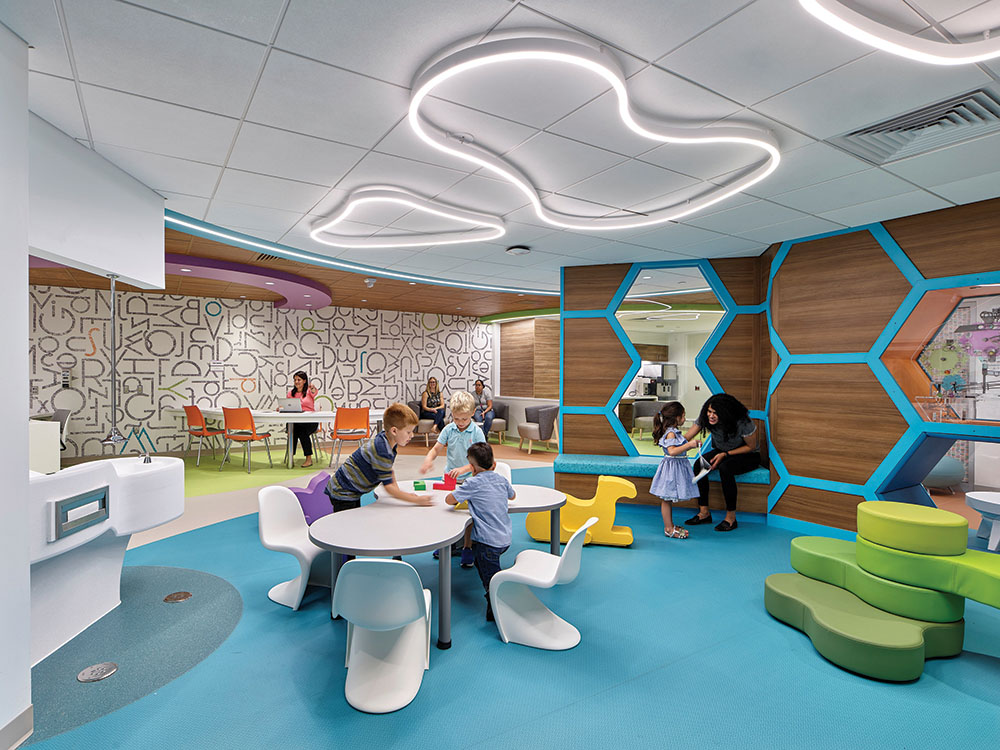The path through childhood is made up of many phases, and the space around us should reflect that growth. In early years, we are drawn to bright colors and charming cartoons. Remember your first bedroom filled with teddy bears, dinosaurs or rainbows — a wonderland for imagination? A few years later and the teddy bears are replaced by toy cars or unicorns. Another few years pass to find posters of a favorite band or sports star adorning our bedroom walls as we navigate the world of teenagerhood — those awkward years. With high school comes cliques, gossip, sports and just trying to find our “place.”
This phase of discovery is often shown in how we decorate our personal space. As we look back, that childhood bedroom evolves as we do and that bedroom becomes a sanctuary — offering comfort and refuge from our day-to-day lives.
How does that affinity for our surroundings translate outside our home? Let’s consider a visit to the doctor.
It’s time for your scheduled appointment with the pediatrician — your doctor from birth until 18. The doctor’s office has games and fun activities to occupy the five-year-old child waiting their turn. But what about the 14-year-old teenager who feels uncomfortable in that same office? They are likely embarrassed to be in such a juvenile space, however the pediatrician is still the best healthcare provider for that teenager.
So how do we make patients ages five and 14 feel comfortable in the same waiting room?
Bridging the gap
Today’s planning and design take on this challenge as a key driver in the layout and shaping of pediatric environments. Our responsibility includes creating spaces that cater to all ages, not just a particular period of a child’s life. Because as patients grow, so should their environment — fostering that sense of change similarly to the fluctuations found throughout a child’s bedroom as they age.
One way to foster this concept is by keeping the design of pediatric spaces neutral with pops of non-primary colors and patterned fabrics, straying away from the thought that designing for children instantly means a bright primary color palette. Furthermore, color can be utilized specifically to foster an effective wayfinding solution to better enhance the patient and family experience.
Along corridors, colors can be applied to soffits that work their way into the main paths of travel — designed to orient users while they move through the space. In addition, flooring accents and patterns can also assist as wayfinding tools and a metric assistant for staff to utilize with patients. Offering design solutions that serve as more than aesthetic intents brings client objectives to the forefront and allows for more practical interior environments.
Positive distractions
In lieu of cartoon decals that quickly lose a growing child’s interest, positive distractions can be brought in through age-appropriate interactive elements. These elements can draw inspiration from everyday activity books. Take for example a digital “seek-and-find” wall, which can be great for a teenager seeking a challenge or for a two-year old simply enjoying the bright colors and fun animations integrated into various schemes.
Another example is the use of automatas, or self-operating machines. Implementing engaging variations that activate with a push of a button, like a chicken driving a tractor or an octopus rowing a boat, offer curious teenage minds the ability to visualize how mechanics work, while offering fun entertainment for children looking to touch and push buttons.
Lighting can be another avenue for introducing interactive play. Lights can be programmed to activate through motion, sound and touch and may be considered a calming distraction for patients prior to their visit. While having stable, consistent elements are great, interactive elements offer the ability to be reprogrammable or “changed out” as the years go on. This ability for change offers a nice breather from the status quo throughout the years — and keeps spaces fresh for patients and staff.
Incorporating nondigital interactive elements offers another means of entertainment. Take a magnetic wall, for example. A magnetic wall offers children a means of creating their own imaginative fun. These types of walls may contain removable pieces that could be connected to create artwork, solve a puzzle or start a simultaneous reaction of spinning parts in various configurations as imagined by the child. This form of interactive engagement offers both enjoyable entertainment for young curious minds and a puzzling challenge for older children attempting to solve puzzles.
Spaces for everyone
Balancing out interactive elements, the utilization of thoughtful furnishings and age-appropriate play and lounge areas provides space for everyone. Play areas can be safe and monitored so children can crawl, explore and play with toys in view of surrounding parent lounges, while introducing spaces with comfortable seating, televisions for gaming and places to relax and “get away” provide teens with a non-childish environment. The inclusion of areas that cater to specific age groups can help family and patients find a spot to call their own.
Taking into consideration the capabilities of various patients, nestling soft seating nooks along corridors and within lounge areas at various heights allow access by children who walk or crawl. Vision panels can be introduced if sightlines are of concern and allow for additional interaction from adjoining rooms. The underlying key is that there’s something for everyone.
Growing up can be challenging enough. But, if we’re able to ease some of these burdens and make children a little less afraid of or dread going to the doctor, that’s a win in our book.





